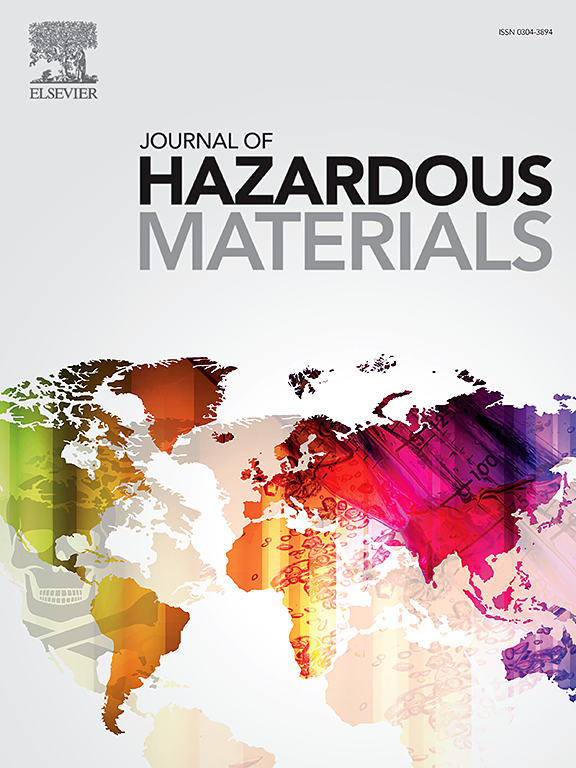大气细颗粒物中有机硫酸盐的分子特征及形成途径——以钢铁工业城市冬季采暖期为例
IF 11.3
1区 环境科学与生态学
Q1 ENGINEERING, ENVIRONMENTAL
引用次数: 0
摘要
空气污染是一个严重的全球性问题,对环境和人类健康都构成严重威胁。有机硫酸盐在雾霾形成过程中发挥着重要作用,但对其分子特征、污染动力学和大气转化过程的研究相对有限。本研究采集了某钢铁工业城市冬季采暖期的25份PM2.5样本,采用傅里叶变换离子回旋共振质谱(FT-ICR MS)对其进行了综合化学表征。共鉴定出6348种含硫化合物,包括CHOS1、CHOS2、CHON1S1、CHON1S2、CHON2S1和CHON2S2。分析表明,这些化合物中有42.0% ~ 95.2%的O/(4S+ 3n)≥1,表明有机硫酸盐(OSs)和硝基氧基有机硫酸盐(NOSs)在样品中普遍存在。不同前体化合物的os和nos的相对比例分别为:长链烷烃(24.9%)、单萜(22.0%)、倍半萜(14.5%)、二萜(5.1%)和萘(2.5%)。对FT-ICR MS数据的进一步分析表明,温度、O3、金属离子、相对湿度和NO2是驱动OSs和nos形成的关键因素。这些结果强调了酸催化的环氧化物开环反应、酯化过程、硫酸盐自由基反应或液相机制在OSs和NOSs形成途径中的关键作用。本文章由计算机程序翻译,如有差异,请以英文原文为准。

Molecular characteristics and formation pathways of organosulfates in atmospheric fine particles: A case study in steel industrial city during winter heating period
Air pollution is a critical global issue, posing serious threats to both the environment and human health. Organosulfates play a significant role in haze formation, yet research on their molecular characteristics, pollution dynamics, and atmospheric transformation processes remains relatively limited. In this study, 25 PM2.5 samples were collected from a steel industrial city during the winter heating period and subjected to comprehensive chemical characterization employing Fourier-transform ion cyclotron resonance mass spectrometry (FT-ICR MS). A total of 6348 sulfur-containing compounds were identified, encompassing CHOS1, CHOS2, CHON1S1, CHON1S2, CHON2S1, and CHON2S2. Analysis showed 42.0–95.2 % of these compounds had O/(4S+3 N)≥ 1, indicating a high prevalence of organosulfates (OSs) and nitrooxy-organosulfates (NOSs) in the samples. OSs and NOSs derived from different precursors showed the following relative proportions: long-chain alkanes (24.9 %), monoterpenes (22.0 %), sesquiterpenes (14.5 %), diterpenes (5.1 %), and naphthalenes (2.5 %). Further analysis of the FT-ICR MS dataset reveals that temperature, O3, metal ions, relative humidity, and NO2 were key factors in driving the formation of OSs and NOSs. These results highlight the critical role of acid-catalyzed epoxide ring-opening reactions, esterification processes, and reactions involving sulfate radicals or liquid-phase mechanisms in the formation pathways of OSs and NOSs.
求助全文
通过发布文献求助,成功后即可免费获取论文全文。
去求助
来源期刊

Journal of Hazardous Materials
工程技术-工程:环境
CiteScore
25.40
自引率
5.90%
发文量
3059
审稿时长
58 days
期刊介绍:
The Journal of Hazardous Materials serves as a global platform for promoting cutting-edge research in the field of Environmental Science and Engineering. Our publication features a wide range of articles, including full-length research papers, review articles, and perspectives, with the aim of enhancing our understanding of the dangers and risks associated with various materials concerning public health and the environment. It is important to note that the term "environmental contaminants" refers specifically to substances that pose hazardous effects through contamination, while excluding those that do not have such impacts on the environment or human health. Moreover, we emphasize the distinction between wastes and hazardous materials in order to provide further clarity on the scope of the journal. We have a keen interest in exploring specific compounds and microbial agents that have adverse effects on the environment.
 求助内容:
求助内容: 应助结果提醒方式:
应助结果提醒方式:


